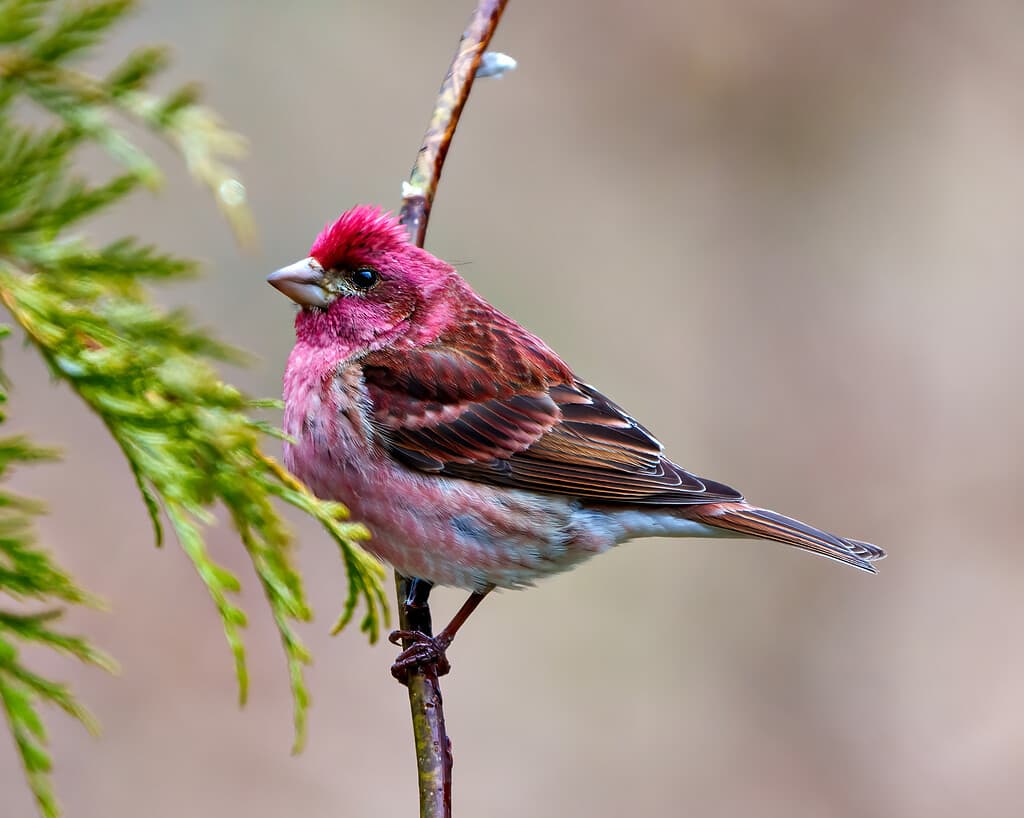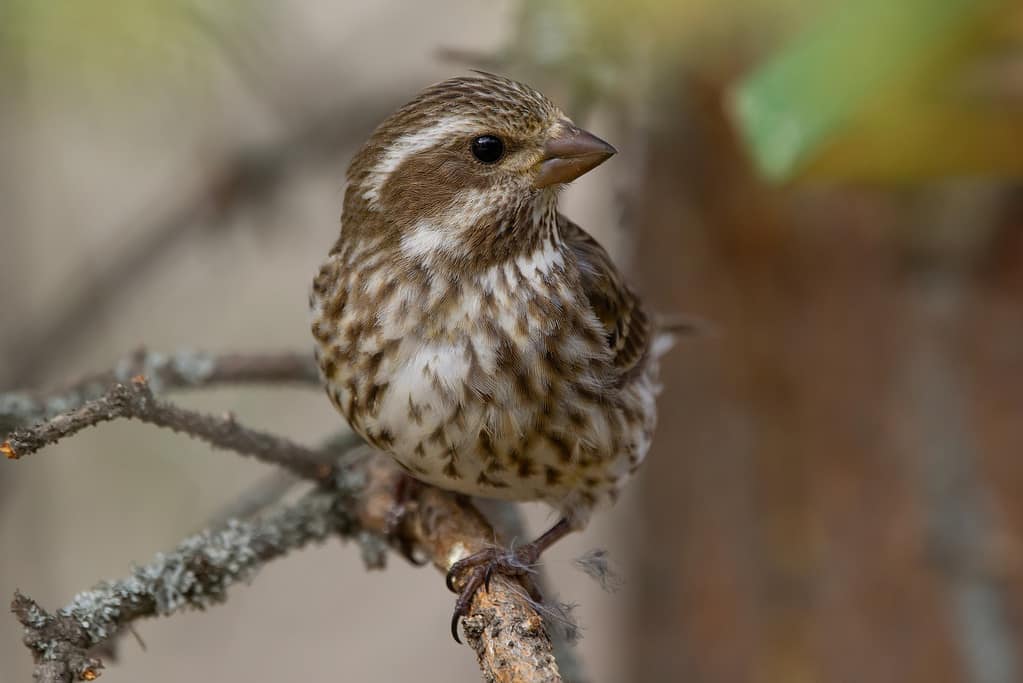The official New Hampshire state bird is the purple finch (Haemorhous purpureus). The purple finch belongs to the Fringillidae family of true finches. This family includes roughly 240 species of songbirds divided into more than 50 genera. Purple finches belong to the Haemorhous genus, along with the house finch and the Cassin’s finch. The state legislature of New Hampshire voted to adopt the purplefinch as their official state bird in 1957. In a decisive vote, the purple finch, supported by a number of groups including the Audubon Society of New Hampshire, the New Hampshire Federation of Garden Clubs, and the State Federation of Women’s Clubs, defeated its opponent, the New Hampshire chicken for the title. The governor of New Hampshire made things official, signing the bill on April 25, 1957.

Where Does the State Bird of New Hampshire Live?

Purple finches can be found throughout New Hampshire. Adult males have a raspberry color all over.
©Rejean Bedard/iStock via Getty Images
Purple finches breed throughout much of Canada, as well as parts of North Dakota and Minnesota. The nominate subspecies, H. p. purpureus, live as breeding, permanent residents throughout the northeastern portion of the United States, from the Great Lakes region to the East Coast and down into parts of Virginia and West Virginia. A second subspecies, H. p. californicus, also breeds along the West Coast all the way south to southern California.
The non-breeding range of purple finches extends east and south of their breeding zone, throughout the eastern half of the United States. This zone runs from South Dakota, Nebraska, Kansas, Oklahoma, and Texas all the way to the East Coast. Purple finches only migrate through the western Dakotas to move between their breeding and non-breeding ranges.
In New Hampshire, purple finches live and breed year-round throughout the state. More of these birds can be found in the less populated northern and western portions of the state, though they can find suitable habitat all over New Hampshire. This bird lives mainly in coniferous and mixed woodland areas. They routinely inhabit forest edges, fields, shrublands, wooded parks, and even backyards in the winter. The size of New Hampshire’s purple finch population in the winter largely depends on the availability of food to the north.
Diet

Purple finches love black oil sunflower seeds, as well as millet and thistle.
©Aaron J Hill/Shutterstock.com
Purple finches eat mainly seeds, especially in the winter. They supplement their diet by occasionally eating insects and larvae, typically the sort found on the trees where they live. Purple finches may also eat buds from trees and different types of berries and small fruits. They often forage in groups when they are not in the middle of a nesting cycle. These birds will also eagerly visit feeders to obtain seeds. Purple finches will eat a variety of different types of seeds, but they seem to love black oil sunflower seeds best of all. They also enjoy millet and thistle seeds. Backyard birdwatchers can attract purple finches to their yards by keeping feeders supplied with seeds that these birds love, especially when their natural food sources run low.
Where Does the State Bird of New Hampshire Nest?
Purple finches form monogamous pairs for their breeding season. They may or may not choose the same mate the next season. Although purple finches form flocks during non-breeding periods, they form solitary pairs while breeding. The breeding season runs from April through August, and these birds usually produce two clutches during that time. Although purple finches may share the same large tree, each male defends his small territory.
Males attempt to draw the attention of a female by fluffing their feathers and hopping, usually with a twig in their bill. If they prove successful, the pair will mate and make a cup-shaped nest in a tree, usually beneath a natural shelter. They fashion their nests from weeds, bark, and rootlets, and they line them with soft, fine materials like grasses and animal hair.
Purple Finch Eggs
Pairs of purple finches typically raise two clutches each year. Each clutch consists of an average of three to six eggs but can range from two to seven. The female lays light-colored, almost white to greenish-blue eggs with dark speckles or markings. She incubates the clutch on her own for 13 days, and almost never leaves the nest during this time. The male stays close by and defends the territory. He also feeds the female regurgitated seeds.
Purple finch chicks are altricial. They hatch naked and helpless with their eyes closed, but they develop very quickly. Both parents feed the chicks regurgitated seeds for approximately 13 to 16 days until they mature enough to leave the nest. Most purple finch chicks fledge by the time they are two weeks old. Fledglings stay near the nest for another week or so, benefiting from the protection and guidance of their parents.
What Do Purple Finches Look Like?

The female purple finch lacks the purplish tint of the male but has similar markings.
©Anna Richard/iStock via Getty Images
The state bird of New Hampshire exhibits significant sexual dimorphism. Males have vibrant color, while females have mostly brown bodies with just a hint of color on their undersides. Although the species is called a purple finch, males are more of a raspberry color than a true purple. Adult males have bright, raspberry-colored heads with lighter bars above and below the eye. Their upper parts also feature a dark raspberry tint over light brown, while the breast and underparts appear lighter. The wings feature two thin bars, lighter in color.
Female purple finches look very similar to males, except without the purplish coloring. They have an overall color of light brown with the same light bars above and below the eye and the same two wing bars as the male. They also have coarse streaking on their breast and underside.
Both male and female purple finches measure about 4.7 to 6.3 inches in length. They have a wingspan of about 8.7 to 10.2 inches, and they weigh 0.6 to 1.1 ounces. They are a bit smaller than most sparrows. Their bodies look round and chunky, with short, notched tails that generally point down. They have conical bills shaped perfectly for gathering seeds.
Purple finches are most easily confused with house finches. These birds are similar in size, shape, and coloring. The male purple finch has more purplish coloring over its body than a house finch, which tends toward a redder hue. Purple finches also have light raspberry coloring on their undersides and flanks, whereas the undersides and flanks of the house finch have streaks of brown.
Are Purple Finches Rare?
Purple finches have an extensive, non-fragmented range and a strong population throughout. This bird can find suitable habitat throughout most of the state of New Hampshire, as well as the rest of their range. The IUCN Red List of Threatened Species lists the purple finch as a species of Least Concern. Although, like most songbirds, the population of the purple finch has declined significantly since the 1960s, the current population remains mostly stable, only slightly declining based on recent counts.
The state bird of New Hampshire is neither rare nor threatened within its range, but depending on the yearly conditions it may be much easier to spot in the winter. When food becomes scarce in the north, migrating individuals move to the area in larger numbers. Backyard birdwatchers should provide multiple bird feeders with their favorite seeds to give these small birds opportunities to get their fill. Otherwise, purple finches may get bullied away from feeders by larger or more aggressive birds.
The photo featured at the top of this post is © Steve Byland/Shutterstock.com
Thank you for reading! Have some feedback for us? Contact the AZ Animals editorial team.






